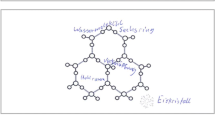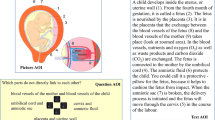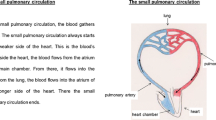Abstract
The term ‘modality effect’ in multimedia learning means that students learn better from pictures combined with spoken rather than written text. The most prominent explanations refer to the split attention between visual text reading and picture observation which could affect transfer of information into working memory, maintenance of information in working memory or the effective size of working memory. The assumption of a continuous need for split attention is questionable, however. Learners can keep pictorial information in working memory, when they have seen the picture before, especially if they have higher prior knowledge. Instead of suffering from a permanent split attention, learners frequently show tendencies to simply ignore pictures. This suggests guiding learners towards picture analysis by picture-related text paragraphs. We assume that these paragraphs are associated with stronger modality effects than content-related paragraphs, especially if the pictures are new to learners. These assumptions were tested in an experiment with 120 students learning about volcanism from illustrated text consisting of segments each including a content-related paragraph followed by a picture-related paragraph describing the accompanying visualization. Content-related and picture-related paragraphs were presented as visual or auditory texts leading to 2x2 conditions of text presentation. Picture novelty was manipulated by presenting a picture throughout the whole segment or only when the picture-related paragraph was read. As expected, picture-related paragraphs were associated with stronger modality effects than content-related paragraphs if picture novelty is high. The distinction between different kinds of paragraphs seems to be important for the prediction of modality effects.


Similar content being viewed by others
References
Amstad, T. (1978). Wie verständlich sind unsere Zeitungen. Dissertation. Universität Zürich.
Ayres, P., & Sweller, J. (2005). The split-attention principle in multimedial learning. In R. E. Mayer (Ed.), The cambridge handbook of multimedia learning (pp. 135–146). Cambridge: Cambridge University Press.
Baddeley, A. D. (1986). Working memory. Oxford: Oxford University Press.
Baddeley, A. D., & Logie, R. H. (1999). Working memory: The multiple-component model. In A. Miyake & P. Shah (Eds.), Models of working memory: Mechanisms of active maintenance and executive control (pp. 28–61). Cambridge: Cambridge Univ. Press.
Bernard, R. M. (1990). Using extended captions to improve learning from instructional text. British Journal of Educational Technology, 21(3), 215–225.
Chafe, W. L. (1994). Discourse, consciousness, and time. Chicago: University of Chicago Press.
Chandler, P., & Sweller, J. (1991). Cognitive load theory and the format of instruction. Cognition and Instruction, 8(4), 293–332.
Clements, P. (1979). The effects of staging on recall from prose. In R. O. Freedle (Ed.), New directions in discourse processing. Vol. II in the series Advances in discourse processes (pp. 287–330). Norwood: Ablex.
Cowan, N. (2001). The magical number 4 in short-term memory: a reconsideration of mental storage capacity. Behavioral and Brain Sciences, 24, 87–185.
Danks, J. H. (1980). Comprehension in listening and reading: Same or different? In J. Danks & K. Pezdek (Eds.), Reading and understanding (pp. 25–40). Newark, Delware: International Reading Association.
Danks, J. H., & End, L. J. (1987). Processing strategies for reading and listening. In R. Horowitz & S. J. Samuels (Eds.), Comprehending oral and written language (pp. 271–294). San Diego: Academic Press.
Diakidoy, I. A., Stylianou, P., Karefillidou, C., & Papageorgiou, P. (2012). The relationship between listening and reading comprehension of different types of text at increasing grade levels. Reading Psychology. doi:10.1080/02702710590910584.
Ellis, A. W., & Young, A. W. (1996). Human cognitive neuropsychology. A textbook with readings. Hove: Psychology Press.
Engelkamp, J. (1982). Given and new information: Theoretical positions and empirical evidence. Saarbrücken: Universität des Saarlandes, Fachrichtung Psychologie im Fachbereich 6, Report No.79.
Ferreira, F., & Anes, M. (1994). Why study spoken language? In M. A. Gernsbacher (Ed.), Handbook of psycholinguistics (pp. 34–36). San Diego: Academic Press.
Ginns, P. (2005). Meta-analysis of the modality effect. Learning and Instruction, 15, 313–331. doi:10.1016/j.learninstruc.2005.07.001.
Givón, T. (Ed.). (1983). Topic continuity in discourse: A quantitative cross-language study. Amsterdam: Benjamins.
Green, R. (1981). Remembering ideas form text: the effect of modality of presentation. British Journal of Educational Psychology, 51, 83–89.
Grimes, J. E. (1975). The thread of discourse. The Hague: Mouton.
Gyselinck, V., Jamet, E., & Dubois, V. (2008). The role of working memory components in multimedia comprehension. Applied Cognitive Psychology, 22, 353–374.
Halliday, M. A. K. (1970). Language structure and language function. In J. Lyons (Ed.), New horizons in linguistics (pp. 140–164). Harmondsworth: Penguin.
Hannus, M., & Hyönä, J. (1999). Utilization of illustrations during learning of science: textbook passages among low- and high-ability children. Contemporary Educational Psychology, 24, 95–123.
Haviland, S. E., & Clark, H. H. (1974). What’s new? Acquiring new information as a process in comprehension. Journal of Verbal Learning and Verbal Behavior, 13, 512–521.
Hegarty, M., & Just, M. A. (1993). Constructing mental models of machines from text and diagrams. Journal of Memory and Language, 32, 717–742.
Hron, A., Kurbjuhn, I., Mandl, H., & Schnotz, W. (1985). Structural inferences in reading and listening. In G. Rickheit & H. Strohner (Eds.), Inferences in text processing (pp. 221–245). Amsterdam: North-Holland.
Jeung, H.-J., Chandler, P., & Sweller, J. (1997). The role of visual indicators in dual sensory mode instruction. Educational Psychology, 17, 329–343. doi:10.1080/0144341970170307.
Kalyuga, S. (2000). When using sound with a text or picture is not beneficial for learning. Australian Journal of Educational Technology, 16(2), 161–172.
Kalyuga, S., Chandler, P., & Sweller, J. (1998). Levels of expertise and instructional design. Human Factors, 40(1), 1–17.
Kalyuga, S., Chandler, P., & Sweller, J. (2000). Incorporating learner experience into the design of multimedia instruction. Journal of Educational Psychology, 92, 126–136.
Kalyuga, S., Ayres, P., Chandler, P., & Sweller, J. (2003). The expertise reversal effect. Educational Psychologist, 38, 23–31.
Kozma, R. (2003). The material features of multiple representations and their cognitive and social affordances for science understanding. Learning and Instruction, 13, 205–226.
Kulhavy, R. W., Lee, B. J., & Caterino, L. C. (1985). Conjoint retention of maps and related discourse. Contemporary Educational Psychology, 10, 28–37.
Kürschner, C., & Schnotz, W. (2008). Das Verhältnis gesprochener und geschriebener Sprache bei der Konstruktion mentaler Repräsentationen. Psychologische Rundschau, 59(3), 139–149.
Landerl, K. (2001). Lesegeschwindigkeitstest (national und international). In G. Haider & B. Lang (Eds.), PISA PLUS 2000 (pp. 119–130). Studien Verlag: Innsbruck.
Leahy, W., & Sweller, J. (2011). Cognitive load theory, modality of presentation and the transient information effect. Applied Cognitive Psychology, 25(6), 943–951.
Leahy, W., Chandler, P., & Sweller, J. (2003). When auditory presentations should and should not be a component of multimedia instruction. Applied Cognitive Psychology, 17(4), 401–418. doi:10.1002/Acp.877.
Levie, H. W., & Lentz, R. (1982). Effects of text illustrations: a review of research. Educational Communication and Technology Journal, 30, 195–232.
Levin, J. R., Anglin, G. J., & Carney, R. N. (1987). On empirically validating functions of pictures in prose. In H. A. Houghton & D. M. Willows (Eds.), The psychology of illustration (pp. 51–86). New York: Springer.
Lindow, S., Fuchs, H. M., Fürstenberg, A., Kleber, J., Schweppe, J., & Rummer, R. (2011). On the robustness of the modality effect: Attempting to replicate a basic finding. Zeitschrift für Pädagogische Psychologie, 25(4), 231–243.
Low, R., & Sweller, J. (2005). The modality principle in multimedia learning. In R. E. Mayer (Ed.), The cambridge handbook of multimedia learning (pp. 147–158). Cambridge: Cambridge University Press.
Lowe, R. K. (1999). Extracting information from an animation during complex visual learning. European Journal of Psychology of Education, 14, 225–244.
Lowe, R. K. (2004). Interrogation of a dynamic visualisation during learning. Learning and Instruction, 14, 257–274.
Massaro, D. W. (1979). Reading and listening. In P. A. Kolers, M. E. Wrolstad, & H. Bouma (Eds.), Processing of visible language (pp. 331–370). New York: Plenum Press.
Mayer, R. E. (1997). Multimedia learning: are we asking the right questions? Educational Psychologist, 32, 1–19.
Mayer, R. E. (2005). Cognitive theory of multimedia learning. In R. E. Mayer (Ed.), The Cambridge handbook of multimedia learning (pp. 31–48). Cambridge: Cambridge University Press.
Mayer, R. E. (2009). Multimedia learning (2nd ed.). New York: Cambridge University Press.
Mayer, R. E., & Moreno, R. (1998). Split-attention effect in multimedia learning: evidence for dual processing systems in working memory. Journal of Educational Psychology, 90, 312–320.
Mayrath, M. C., Nihalani, P. K., & Robinson, D. H. (2011). Varying tutorial modality and interface restrictions to maximize transfer in a complex simulation environment. Journal of Educational Psychology, 103, 257–268.
McDonald, T., & Thornley, C. (2002). Unlocking meaning in text: some thoughts on the literacy challenges our students face. English in Aotearoa, 48, 54–60.
Miller, G. A. (1956). The magical number seven, plus or minus two: some limits on our capacity to process information. Psychological Review, 63, 81–97.
Mokros, J. R., & Tinker, R. F. (1987). The Impact of microcomputer-based labs on children's ability to interpret graphs. Journal of Research in Science Teaching, 24, 369–383.
Moreno, R., & Durán, R. (2004). Do multiple representations need explanations? The role of verbal guidance and individual differences in multimedia mathematics learning. Journal of Educational Psychology, 96(3), 492–503.
Moreno, R., & Mayer, R. E. (1999). Cognitive principles of multimedia learning: the role of modality and contiguity. Journal of Educational Psychology, 91, 358–368.
Mousavi, S. Y., Low, R., & Sweller, J. (1995). Reducing cognitive load by mixing auditory and visual presentation modes. Journal of Educational Psychology, 87, 319–334. doi:10.1037/0022-0663.87.2.319.
Peterson, L., & Peterson, M. (1959). Short-term retention of individual verbal items. Journal of Experimental Psychology, 58, 193–198.
Ploetzner, R., Lowe, R., & Schlag, S. (2013). A systematic characterization of cognitive techniques for learning from textual and pictorial representations. Journal of Education and Learning, 2(2), 78–95.
Rieben, L., & Perfetti, C. (1991). Learning to read: Basic research and its implications. Hillsdale: Erlbaum.
Rubin, D. L., Hafer, T., & Arata, K. (2000). Reading and listening to oral-based versus literate-based discourse. Communication Education, 49(2), 121–133.
Rummer, R., Schweppe, J., Fürstenberg, A., Seufert, T., & Brünken, R. (2010). Working memory interference during processing texts and pictures: implications for the explanation of the modality effect. Applied Cognitive Psychology, 24, 164–176.
Schmidt-Weigand, F. (2011). Does animation amplify the modality effect – or is there any modality effect at all? Zeitschrift für Pädagogische Psychologie.
Schmidt-Weigand, F., Kohnert, A., & Glowalla, U. (2010a). Explaining the modality and contiguity effects: New insights from investigating Students' viewing behaviour. Applied Cognitive Psychology, 24, 226–237. doi:10.1002/Acp.1554.
Schmidt-Weigand, F., Kohnert, A., & Glowalla, U. (2010b). A closer look at split visual attention in system- and self-paced instruction in multimedia learning. Learning and Instruction, 20, 100–110. doi:10.1016/j.learninstruc.2009.02.011.
Schnotz, W. (2005). An integrated model of text and picture comprehension. In R. E. Mayer (Ed.), Cambridge handbook of multimedia learning (pp. 49–69). Cambridge: Cambridge University Press.
Schnotz, W. (2011). Colorful bouquets in multimedia research: a closer look at the modality effect. Zeitschrift für Pädagogische Psychologie, 25, 269–276.
Schüler, A., Scheiter, K., & Schmidt-Weigand, F. (2011). Boundary conditions and constraints of the modality effect. Zeitschrift für Pädagogische Psychologie, 25, 211–220.
Sticht, T. G., & James, J. H. (1984). Listening and reading. In P. D. Pearson, R. Barr, M. L. Kamil, & P. Mosenthal (Eds.), Handbook of reading research (pp. 293–317). New York: Longmann.
Stiller, K. D., Freitag, A., Zinnbauer, P., & Freitag, C. (2009). How pacing of multimedia instructions can influence modality effects: a case of superiority of visual texts. Australasian Journal of Educational Technology, 25, 184–203.
Tabbers, H. K., & van der Spoel, W. (2011). Where did the modality principle in multimedia learning go? A double replication failure that questions both theory and practical use. Zeitschrift für Pädagogische Psychologie, 25(4), 221–230.
Tabbers, H. K., Martens, R. L., & van Merriënboer, J. J. G. (2004). Multimedia instructions and cognitive load theory: effects of modality and cueing. British Journal of Educational Psychology, 74, 71–81.
Tindall-Ford, S., Chandler, P., & Sweller, J. (1997). When two sensory modes are better than one. Journal of Experimental Psychology: Applied, 3, 257–287.
Weidenmann, B. (1989). When good pictures fail: An information-processing approach to the effects of illustrations. In H. Mandl & J. R. Levin (Eds.), Knowledge acquisition from text and pictures (pp. 157–170). Amsterdam: Elsevier.
Yeung, A. S., Jin, P., & Sweller, J. (1997). Cognitive load and learner expertise: split-attention and redundancy effects in reading with explanatory notes. Contemporary Educational Psychology, 23, 1–21.
Author information
Authors and Affiliations
Corresponding author
Additional information
Wolfgang Schnotz. Faculty of Psychology, General and Educational Psychology, University of Koblenz-Landau, Fortstraße 7, 76829 Landau, Germany. schnotz@uni-landau.de. Phone: +49-634128034234; Fax: +49-634128034240; Email: schnotz@uni-landau.de
Current themes of research:
Text-Picture Integration, Knowledge Acquisition from Multiple Representations, Knowledge Acquisition with Conflicting Information, Multimedia Learning, Learning with Hypermedia, Learning with Animation
Most relevant publications in the field of Psychology of Education:
Schnotz, W. (2011). Colorful Bouquets in Multimedia Research: A Closer Look at the Modality Effect. Zeitschrift für Pädagogische Psychologie. 25, 269–276.
Schnotz, W., Baadte, C., Müller, A., & Rasch, R. (2010). Creative thinking and problem solving with depictive and descriptive representations. . In L. Verschaffel, E. De Corte, T. de Jong & J. Elen (Eds.) Use of representations in reasoning and problem solving (pp. 11–35). London: Routledge.
Schnotz, W., & Heiß, A. (2009). Semantic Scaffolds in Hypermedia Learning Environments. Computers in Human Behavior, 25(2), 371–380.
Schnotz, W. & Kürschner, C. (2007). A reconsideration of cognitive load theory. Educational Psychology Review, 19(4), 469–508.
Schnotz, W. & Lowe, R.K. (2008). A unified view of learning from animated and static graphics. In R.K. Lowe & W. Schnotz (Eds.), Learning with animation. Research implications for design (pp. 304–356). New York: Cambridge University Press.
Christoph Mengelkamp. University of Würzburg, Philosophical Faculty II, Oswald-Külpe-Weg 82, 97074 Würzburg, Germany. christoph.mengelkamp@uni-wuerzburg.de
Current themes of research:
metacognition in self-regulated learning, interactive animations, learning from pictures and texts, educational diagnostics and methodology
Most relevant publications in the field of Psychology of Education:
Mengelkamp, C., & Bannert, M. (2012). Confidence judgments in learning. In N. M. Seel (Ed.), Encyclopledia of the sciences of learning (pp. 756–759). New York: Springer. doi:10.1007/978-1-4419-1428-6 doi:10.1007/978-1-4419-1428-6#_blank
Mengelkamp, C., & Bannert, M. (2010). Accuracy of confidence judgments: Stability and generality in the learning process and predictive validity for learning outcome. Memory and Cognition, 38, 441–451. doi:10.3758/MC.38.4.441 doi:10.3758/MC.38.4.441#_blank
Bannert, M., Hildebrand, M., & Mengelkamp, C. (2009). Effects of a metacognitive support device in learning environments. Computers in Human Behaviour, 25, 829–835. doi:10.1016/j.chb.2008.07.002 doi:10.1016/j.chb.2008.07.002#_blank
Mengelkamp, C., & Bannert, M. (2009). Judgements about knowledge: searching for factors that influence their validity. Electronic Journal of Research in Educational Psychology, 7(1), 163–190.
Bannert, M., & Mengelkamp, C. (2008). Assessment of metacognitive skills by means of instruction to think aloud and reflect when prompted. Does the verbalisation method affect learning? Metacognition and Learning, 3, 39–58. doi:10.1007/s11409-007-9009-6 doi:10.1007/s11409-007-9009-6#_blank .
Christiane Baadte. University of Koblenz-Landau, Faculty of Psychology, Fortstraße 7, 76829 Landau, Germany. baadte@uni-landau.de
Current themes of research:
Diagnostic and didactic competencies of teachers, feedback with self-regulated learning with text-picture integration, working memory and multimedia learning
Most relevant publications in the field of Psychology of Education:
Baadte, C. & Dutke, S. (in press). Learning about persons: The effects of text structure and executive capacity on conceptual change. European Journal of Psychology of Education. doi:10.1007/s10212-012-0153-2
Baadte, C. & Dutke, S. (in press). Learning About Persons: The Effects of Text Structure and Executive Capacity on Conceptual Change. European Journal of Psychology of Education.
Baadte, C. & Schnotz, W. (in press). Feedback Effects on performance, motivation and mood: Are they moderated by the learner's self-concept? Scandinavian Journal of Educational Research.
Baadte, C. & Schnotz, W. (2012). Grundlagen des Verstehens von Texten mit Bildern. Weiterbildung, 6, S.35-38.
Dutke, S., Baadte, C., Hähnel, A., von Hecker, U., & Rinck, M. (2010). Using diagnostic text information to constrain situation models. Discourse Processes, 47 (6), 510–544.
Georg Hauck. Rhine-Waal University of Applied Sciences, Communication and Environment, Südstraße 8, 47475 Kamp-Lintfort, Germany. georg.hauck@hochschule-rhein-waal.de
Current themes of research:
Instructional media, communication and organizational counseling
Most relevant publications in the field of Psychology of Education:
Kürschner, C., Seufert, T., Hauck, G., Schnotz, W. & Eid, M. (2006). Konstruktion visuell-räumlicher Repräsentationen beim Hör- und Leseverstehen. Zeitschrift für Psychologie, 214(3), S. 117--132.
Kürschner, C., Schnotz, W., Eid, M. & Hauck, G. (2005). Individuelle Modalitätspräferenzen beim Textverstehen. Zeitschrift für Entwicklungspsychologie und Pädagogische Psychologie, 37(1), 2--16.
Hauck, G. (2008). Der Aufbau von Wissensstrukturen mit Bildern. Saarbrücken: VDM.
Hauck, G. (2005). Effekte von Modalitätspräferenzen beim Wissenserwerb mit multimedialen Lernsystemen. Berlin: Logos.
Appendix
Appendix
Rights and permissions
About this article
Cite this article
Schnotz, W., Mengelkamp, C., Baadte, C. et al. Focus of attention and choice of text modality in multimedia learning. Eur J Psychol Educ 29, 483–501 (2014). https://doi.org/10.1007/s10212-013-0209-y
Received:
Revised:
Accepted:
Published:
Issue Date:
DOI: https://doi.org/10.1007/s10212-013-0209-y




